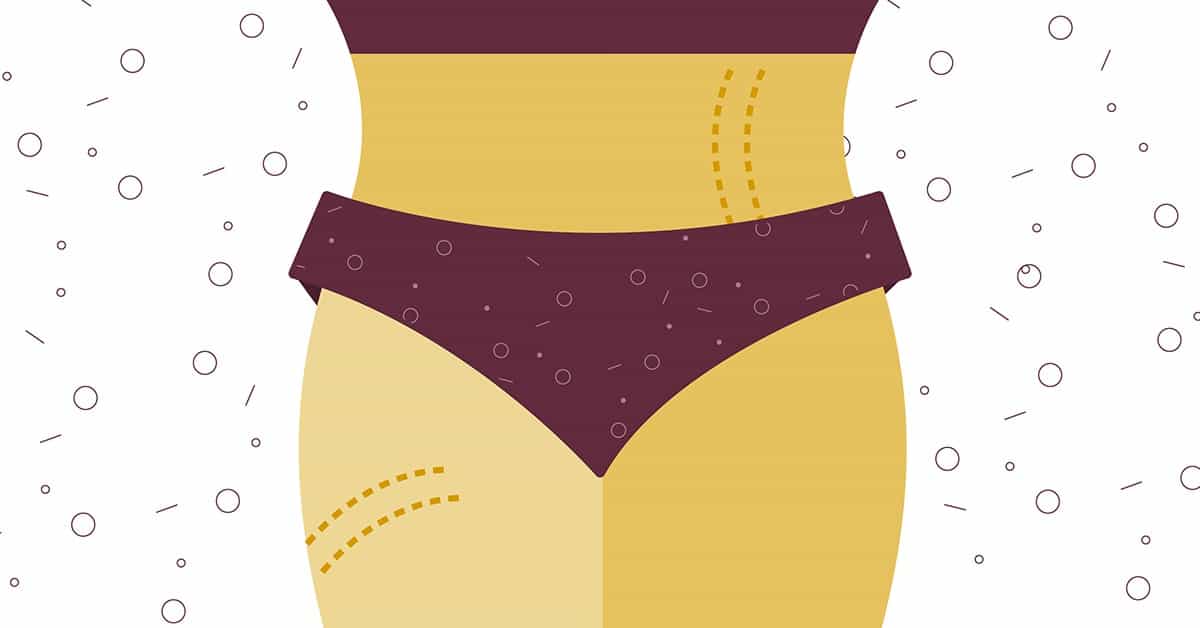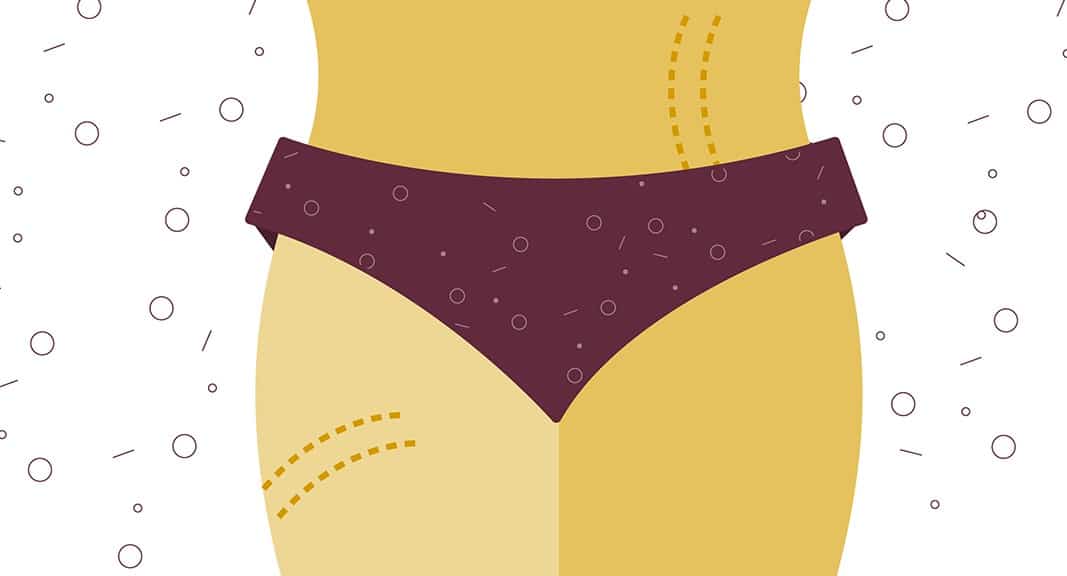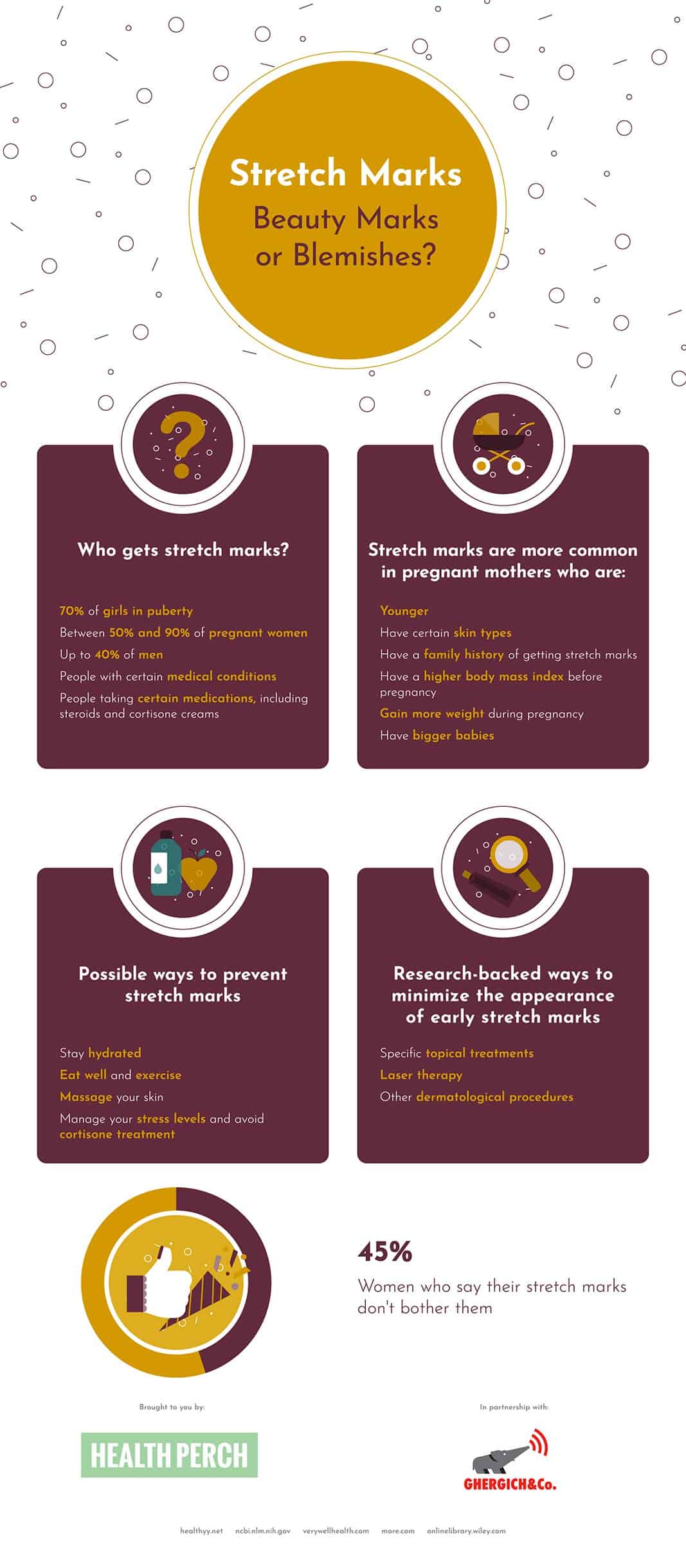Google “celebrity stretch marks” or search for #LoveYourLines on Instagram, and you’ll find that stretch marks can happen to anyone. The long, narrow streaks, stripes, or lines occur when the collagen and elastic tissue in the skin is damaged from stretching quickly, such as during puberty, pregnancy, or during rapid weight gain. Rapid weight loss can also cause stretch marks if excess skin pulls on healthy skin. Stretch marks are more common in women than men and frequently occur on the stomach, thighs, hips, breasts, upper arms, and lower back. They’re typically red or purple at first and later fade to pale white.
Stretch marks are not dangerous, and you can embrace them just the way they are. For some women, stretch marks are a reminder of growing another human being. But if you’d rather prevent them or reduce their appearance, there’s nothing wrong with that either. Let’s dig into the research on who’s most likely to get stretch marks and the best ways to avoid getting them or how to minimize their appearance.
Risk Factors
Stretch marks occur in as many as 70 percent of girls in puberty and somewhere between 50 to 90 percent of pregnant women. Up to 40 percent of men may get them as well, although it’s difficult to tell exactly how many.
During pregnancy, stretch marks are more likely to occur in younger mothers, perhaps because they have firmer, tighter skin. In one study of 800 pregnant women, 84 percent of teen moms got stretch marks compared to 24 percent of moms older than 30. Furthermore, 20 percent of teens got severe stretch marks that weren’t seen in mothers older than 30.
Stretch marks are also more common in mothers who have a higher body mass index before pregnancy, who gain more weight during pregnancy, who have bigger babies, and who have a family history of getting stretch marks. Women with certain skin types, including very fair skin, are also more likely to get stretch marks.
How to Prevent Stretch Marks
Bad news: If you’ve been shelling out big bucks for topical creams, lotions, or ointments to prevent stretch marks, it may be money wasted. Most topical remedies advertised for preventing stretch marks aren’t evidence based, according to a Cochrane Systematic Review.
So what can you do? These solutions may help.
1. Stay hydrated
In one study, women who avoided stretch marks drank an average of 8.3 glasses per day, about one cup more per day than women who got stretch marks. It’s unclear whether hydration made the difference, but it doesn’t hurt to drink more water.
2. Eat well and exercise
Studies on diet and stretch marks are inconclusive and more research is needed. But diet and exercise can help you maintain a healthy weight, which may help prevent stretch marks. Make sure your diet is rich in the nutrients your body needs to produce collagen, the main structural protein found in skin and connective tissue. Critical nutrients include protein, vitamin A, vitamin C, vitamin E, zinc, and silica. Women with lower vitamin D levels are more likely to get stretch marks, so be sure you’re getting enough either through sun exposure, diet, or supplementation. Mushrooms, egg yolks, and fatty fish are good dietary sources of vitamin D.
Many people swear taking collagen prevents stretch marks. Collagen naturally occurs in gelatin powder, chicken stock, and bone broth, or you can take it in a supplement. There are no studies on collagen’s impact on stretch marks, but several studies suggest collagen supplements improve skin elasticity and hydration in the short term. (Pregnant women should talk to their medical care provider before taking any supplements.)
3. Massage your belly
In studies, natural topical remedies, including cocoa butter, olive oil, and collagen hydrolysates, have not been shown to prevent stretch marks in a statistically significant way. However, simply massaging the expanding areas of your body may invigorate blood flow and spur skin growth. In a study, 20 percent of women who massaged their skin with bitter almond oil got stretch marks, compared to 38.8 percent who applied bitter almond oil without massage, and 41.2 percent of women in a control group. Clearly, self-massage was the winner in this study, and there’s no downside.
4. Avoid cortisone treatment and manage stress levels
Cortisol is a hormone made in the adrenal glands and released into the blood to control the body’s blood sugar levels and regulate metabolism. When too much cortisol circulates in the blood stream (such as when someone takes a corticosteroid medicine), stretch marks are more likely to form.
Frequent stress elevates cortisol levels and thus may also make your skin more prone to stretch marks. More research is needed on the topic, but in the meantime, it doesn’t hurt to manage chronic stress by getting enough sleep, eating regularly, exercising, going out in nature, enjoying social activities, and limiting nerve-wracking undertakings.
How to Treat Existing Stretch Marks
Your stretch marks may not go away completely, but it’s possible to minimize their appearance, New stretch marks respond better to treatment than older ones, so get started early and investigate these research-backed methods.
1. Topical treatments
Treatment with tretinoin, an ointment made of a vitamin-A derivative, shows positive results in reducing the severity of stretch marks in clinical trials, but it should not be used by pregnant or breastfeeding moms. A topical treatment containing hydroxyprolisilane C, rose hip oil, Centella asiatica triterpenes, and vitamin E was shown to reduce the severity of early stretch marks in another study.
2. Laser therapy
Dermatological treatment with pulsed lasers induces the formation of new collagen and reduces the appearance of early stretch marks.
3. Other dermatological therapies
Microdermabrasion, micro-needling, and different types of radiofrequency therapy may also reduce the appearance of early stretch marks.
Medical interventions can be expensive and come with risks. If you’re interested in minimizing your stretch marks, talk to a dermatologist about the pros and cons of different therapies.
Conclusion
Nearly half (45 percent) of women in one study said their stretch marks don’t bother them. If you think of stretch marks as your tiger stripes or a badge of honor, keep celebrating them! If you’d prefer to prevent or minimize them, give these research-backed methods a try.


